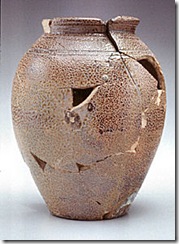Part One:
“The poor potter is Dead, and the Business of making potts and panns is of little advantage to his family, and as little Damage to the Trade of our Mother Country.”
– William Gooch, Royal Governor of Virginia in his 1745 status report to the Lords Commissioners for Trade and Plantations regarding Yorktown potter William Rogers.
Gooch had regularly dismissed this poor potter to the Commissioners since 1732. Yet during that time Rogers operated a huge earthenware and stoneware manufactory. He made everything from crocks to bird houses. His specialty was Fulham style stoneware mugs, fired in special saggars.
Rogers didn’t just make pottery. He flaunted it. His wares were traded (in his own ships) from New England to the West Indies. His operation was probably the largest of it’s kind in Colonial America at the time. I’ve visited his kiln site. It’s huge. (It’s not far from where a British army under Lord Cornwallis surrendered to George Washington’s Continental Army and their French Navy allies in the last major military clash of the Revolutionary War thirty four years later.)
Rogers also ran a brewery, was “Surveyor of the Landings, Streets and Cosways in York Town” (allowing him to use his shards to pave streets), and Captain of the Troop. In short, he was one of the wealthiest people of the colony.
Royal governors were supposed to enforce laws suppressing colonial production of consumer goods. Such goods were meant to be purchased from factories of metropolitan England. But many governors, like Gooch, supported the locals by issuing bogus reports about “poor potters” and such. It’s possible Rogers was just a pottery owner, given the extent of his other activities and his wealth. Who ever heard of a rich potter? Still, all existing accounts of him highlight his potting activities. So I prefer to think of him as the country’s first major pottery figure.
If he wasn’t, why should Gooch mention him at all?
Readings:
Ceramics in America. Ian Quimby, Ed. University Press of Virginia/Charlottesville. 1972.
Domestic Pottery of the Northeastern United States, 1625-1850. Sarah Peabody Turnbaugh, Ed. Academic Press/New York. 1985.
The Art of the Potter. Diana and J. Garrison Stradling. Main Street-Universe Books/New York. 1977.
The “Poor Potter” of Yorktown. C. Malcom Watkins and Ivor Noel Hume. United States National Museum Bulletin 249. Smithsonian Institution Press. 1967.
September 17, 2009 at 1:14 pm |
The jar in the illustration looks salt glazed. Is that the case?
September 17, 2009 at 5:01 pm |
Yes, the jar is salt glazed. The “Fulham Style” mugs were also, along with an assortment of bowls and other table ware. “Fulham” style was salt fired, with the rim dipped in a dark slip. John Dwight had developed this style in England sometime around 1680, which was pretty advanced stuff even then. So it’s all the more remarkable that someone in the boonies of Virginia Colony was doing almost the exact same thing just a generation later. Perhaps I should have mentioned that in the blog, but I’ve been told to keep it short and sweet. A hard thing to do sometimes…
December 10, 2009 at 2:06 pm |
Fantastic, really amazing topic. I will blog about it also!!
August 14, 2011 at 3:30 pm |
[…] in the barn and kitchen. It was the ‘tupperware’ of the day. The American Revolution’s goal of self sufficiency, showcasing native talent in the face of embargo and blockade, was about to begin. Daniel Bailey […]
March 18, 2012 at 12:27 pm |
[…] But being in a port city also meant that business ground to a halt during the blockade years of the Revolutionary War. Afterward, Mead picked up the pieces and kept the shop […]